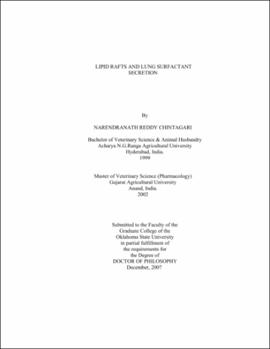| dc.contributor.advisor | Liu, Lin | |
| dc.contributor.author | Chintagari, Narendranath Reddy | |
| dc.date.accessioned | 2013-11-26T08:35:14Z | |
| dc.date.available | 2013-11-26T08:35:14Z | |
| dc.date.issued | 2007-12 | |
| dc.identifier.uri | https://hdl.handle.net/11244/7657 | |
| dc.description.abstract | Scope and Method of Study: The present study was initiated to elucidate the role of lipid rafts in lung surfactant secretion. Lipid rafts were isolated and probed for the association of SNARE proteins. Cholesterol depletion was done to study its role in modulating the surfactant secretion and membrane fusion. Flotillin proteins were silenced to examine their role in surfactant secretion. Finally, we determined the proteomic profile of type II cell lipid rafts to identify novel proteins in this unique subproteome and study the roles of one of the identified proteins, namely, vATPases, in surfactant secretion. We have used a number of techniques including RT-PCR, immunoblotting, immunoflorescence, secretion assay, membrane fusion assay, isolation of plasma membrane and lamellar bodies, and RNA interference to address the biological phenomenon. | |
| dc.description.abstract | Findings and Conclusions: | |
| dc.description.abstract | 1. SNARE proteins were differentially associated with lipid rafts in a cholesterol dependent manner. | |
| dc.description.abstract | 2. Cholesterol depletion drastically reduced surfactant secretion, membrane fusion and fusion pore formation. | |
| dc.description.abstract | 3. SNARE proteins were associated with CD44 clusters. | |
| dc.description.abstract | 4. Flotillin-2 but not -1 reduced surfactant secretion. | |
| dc.description.abstract | 5. Flotillin (s) did not affect the association of SNARE proteins with rafts. | |
| dc.description.abstract | 6. Lipid raft formation was not altered by knockdown of flotillin-1 and -2. | |
| dc.description.abstract | 7. Type II cell lipid raft proteome contained proteins involved in cell proliferation, pH regulation and energy metabolism. | |
| dc.description.abstract | 8. V-ATPases mediate the acidification of lamellar bodies and V-ATPase inhibition leads to increased surfactant secretion. | |
| dc.description.abstract | 9. V-ATPase inhibition leads to the mobilization of Ca2+ from lamellar bodies, which in turn cause further release of Ca2+ from ER. The net surge activates protein kinase C and Ca2+/calmodulin-dependent kinase II leading to increased secretion. | |
| dc.format | application/pdf | |
| dc.language | en_US | |
| dc.rights | Copyright is held by the author who has granted the Oklahoma State University Library the non-exclusive right to share this material in its institutional repository. Contact Digital Library Services at lib-dls@okstate.edu or 405-744-9161 for the permission policy on the use, reproduction or distribution of this material. | |
| dc.title | Lipid rafts and lung surfactant secretion | |
| dc.contributor.committeeMember | Cross, Nicholas L. | |
| dc.contributor.committeeMember | Flanders, Bret N. | |
| dc.contributor.committeeMember | Ownby, Charlotte L. | |
| osu.filename | Chintagari_okstate_0664D_2550.pdf | |
| osu.accesstype | Open Access | |
| dc.type.genre | Dissertation | |
| dc.type.material | Text | |
| thesis.degree.discipline | Veterinary Biomedical Sciences | |
| thesis.degree.grantor | Oklahoma State University | |
